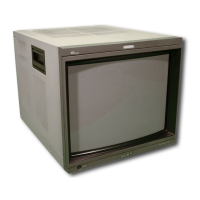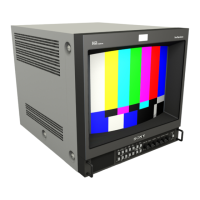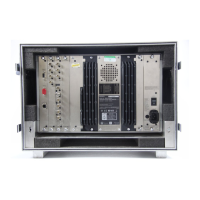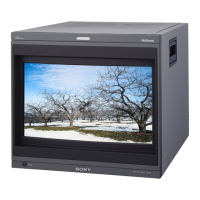
Do you have a question about the Sony TRINITRON BVM-20E1E and is the answer not in the manual?
| Screen Size | 20 inches |
|---|---|
| Display Type | CRT |
| Resolution | Up to 800 TV lines |
| Aspect Ratio | 4:3 |
| Power Consumption | 120 W |
| Input Connectors | BNC, Composite |
| Signal Standard | NTSC, PAL |
Important safety, installation, cleaning, repacking, magnetism, and CRT precautions detailed.
Introduction to the BVM-series color video monitors and their suitability for professional use.
Highlights of key features like high-resolution picture tube, separate control units, and monitor group control capabilities.
Lists external control units, screen masks, and rack mount kits for enhancing monitor functionality.
Information on configuring input connectors with optional decoder and expansion adaptors for diverse signals.
Explains how input/output connector panels can be assembled using optional adaptors for various signal types.
Explains selection priority when multiple NTSC/PAL decoder adaptors are installed.
Guidance on the correct installation procedure for BKM-20D/21D adaptors to prevent interference.
Detailed identification and function of buttons, lamps, and connectors on the monitor's front panel.
Identification and function of rear panel connectors, switches, and power input for connectivity.
Instructions for inserting and ejecting the optional monitor memory card for data storage.
Describes the purpose of the OPTION connector for connecting external control units or probes.
Explains how to navigate and use the monitor's on-screen menus and operation buttons for settings.
Overview of the monitor's menu system, including levels, structure, and constituent menus.
Explanation of how menu numbers are used to classify and navigate complex menu trees.
How to select specific monitors or groups for remote control operations using monitor addresses.
A diagram illustrating the menu system structure from the main menu down to level 2.
How to set preset values for contrast, brightness, chroma, and phase using manual or auto adjustments.
Procedures for adjusting color temperature using knobs, probes, or copying data from other sources.
Setting input signal data, type, format, and channel names for each specific input connector.
Applying and managing four-digit passwords to protect specific menu settings from unauthorized changes.
Configuring channel entry methods, power-up conditions, degauss delay, and AFC time constants.
Selecting and configuring information like VITC, caption vision, and channel names displayed on the monitor screen.
Adjusting screen convergence and geometry for optimal picture alignment and shape correction.
Executing functions like restoring factory defaults, managing memory card data, and restarting the monitor.
Performing save, load, delete, and format operations for monitor data stored on memory cards.
Sharing setup data between multiple monitors connected via serial remote ports for consistent configuration.
Viewing general monitor data and information about signals assigned to the rear panel option slots.
Choosing which monitor or group to control, or performing operations on all connected monitors remotely.
How to cancel an active remote control mode, returning control to the local unit.
Using shortcuts to quickly select target monitors without navigating the full ADDRESS menu for efficiency.
Detailed technical specifications for system, CRT, dimensions, mass, and input/output connectors.
A list of accessories provided with the monitor, such as power cords and operation manuals.
Diagrams and specifications for cables required to connect various color temperature probes to the monitor.











